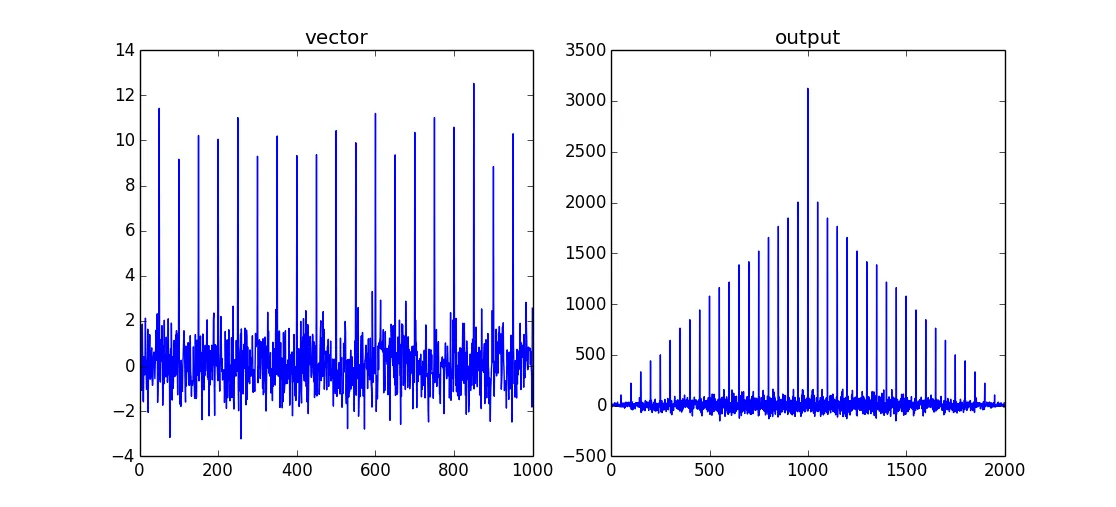我有两个一维数组,想要查看它们之间的相互关系。在numpy中应该使用哪个过程?我正在使用numpy.corrcoef(arrayA, arrayB)和numpy.correlate(arrayA, arrayB),但两者都给出了一些我无法理解或理解的结果。
请问有人可以解释如何理解和解释这些数字结果(最好使用示例)吗?
我有两个一维数组,想要查看它们之间的相互关系。在numpy中应该使用哪个过程?我正在使用numpy.corrcoef(arrayA, arrayB)和numpy.correlate(arrayA, arrayB),但两者都给出了一些我无法理解或理解的结果。
请问有人可以解释如何理解和解释这些数字结果(最好使用示例)吗?
numpy.correlate函数仅返回两个向量的交叉相关性。
如果您需要了解交叉相关性,请从http://en.wikipedia.org/wiki/Cross-correlation开始。
一个很好的例子是看自相关函数(一个向量与其自身进行交叉相关):
import numpy as np
# create a vector
vector = np.random.normal(0,1,size=1000)
# insert a signal into vector
vector[::50]+=10
# perform cross-correlation for all data points
output = np.correlate(vector,vector,mode='full')

这将返回一个具有最大值的梳形/沙函数,当两个数据集重叠时,它会达到最大值。由于这是一种自相关,因此两个输入信号之间不会有“滞后”。因此,相关的最大值为vector.size-1。
如果您只想获取重叠数据的相关值,则可以使用mode='valid'。
目前我只能评论 numpy.correlate。它是一个强大的工具。我使用它有两个目的。第一个是在另一个模式中查找模式:
import numpy as np
import matplotlib.pyplot as plt
some_data = np.random.uniform(0,1,size=100)
subset = some_data[42:50]
mean = np.mean(some_data)
some_data_normalised = some_data - mean
subset_normalised = subset - mean
correlated = np.correlate(some_data_normalised, subset_normalised)
max_index = np.argmax(correlated) # 42 !
我使用它的第二个用途(以及如何解释结果)是用于频率检测:
hz_a = np.cos(np.linspace(0,np.pi*6,100))
hz_b = np.cos(np.linspace(0,np.pi*4,100))
f, axarr = plt.subplots(2, sharex=True)
axarr[0].plot(hz_a)
axarr[0].plot(hz_b)
axarr[0].grid(True)
hz_a_autocorrelation = np.correlate(hz_a,hz_a,'same')[round(len(hz_a)/2):]
hz_b_autocorrelation = np.correlate(hz_b,hz_b,'same')[round(len(hz_b)/2):]
axarr[1].plot(hz_a_autocorrelation)
axarr[1].plot(hz_b_autocorrelation)
axarr[1].grid(True)
plt.show()
找到第二个峰值的索引。从这里可以倒推出频率。
first_min_index = np.argmin(hz_a_autocorrelation)
second_max_index = np.argmax(hz_a_autocorrelation[first_min_index:])
frequency = 1/second_max_index
在阅读所有教科书的定义和公式后,对于初学者来说,仅仅看到如何从一个中推导出另一个是很有用的。首先,重点关注仅涉及两个向量之间的简单情况。
import numpy as np
arrayA = [ .1, .2, .4 ]
arrayB = [ .3, .1, .3 ]
np.corrcoef( arrayA, arrayB )[0,1] #see Homework bellow why we are using just one cell
>>> 0.18898223650461365
def my_corrcoef( x, y ):
mean_x = np.mean( x )
mean_y = np.mean( y )
std_x = np.std ( x )
std_y = np.std ( y )
n = len ( x )
return np.correlate( x - mean_x, y - mean_y, mode = 'valid' )[0] / n / ( std_x * std_y )
my_corrcoef( arrayA, arrayB )
>>> 0.1889822365046136
作业:
scipy.stats.pearsonr在(arrayA,arrayB)上的操作。还有一个提示:请注意,在此输入中以“valid”模式使用的np.correlate只是一个点积(与上面的my_corrcoef最后一行进行比较):
def my_corrcoef1( x, y ):
mean_x = np.mean( x )
mean_y = np.mean( y )
std_x = np.std ( x )
std_y = np.std ( y )
n = len ( x )
return (( x - mean_x ) * ( y - mean_y )).sum() / n / ( std_x * std_y )
my_corrcoef1( arrayA, arrayB )
>>> 0.1889822365046136
如果您对 int 向量的结果感到困惑,那可能是由于溢出所致:
>>> a = np.array([4,3,2,0,0,10000,0,0], dtype='int16')
>>> np.correlate(a,a[:3], mode='valid')
array([ 29, 18, 8, 20000, 30000, -25536], dtype=int16)
怎么回事?
29 = 4*4 + 3*3 + 2*2
18 = 4*3 + 3*2 + 2*0
8 = 4*2 + 3*0 + 2*0
...
40000 = 4*10000 + 3*0 + 2*0 shows up as 40000 - 2**16 = -25536
免责声明:这不会为“如何解释”提供答案,但是介绍了两者之间的区别:
它们之间的区别
Pearson乘积矩相关系数 (
np.corrcoef) 是一个 交叉相关 (np.correlate) 的标准化版本, (来源)
因此,np.corrcoef 总是在 -1..+1 的范围内,因此我们可以更好地比较不同的数据。
让我举个例子
import numpy as np
import matplotlib.pyplot as plt
# 1. We make y1 and add noise to it
x = np.arange(0,100)
y1 = np.arange(0,100) + np.random.normal(0, 10.0, 100)
# 2. y2 is exactly y1, but 5 times bigger
y2 = y1 * 5
# 3. By looking at the plot we clearly see that the two lines have the same shape
fig, axs = plt.subplots(1,2, figsize=(10,5))
axs[0].plot(x,y1)
axs[1].plot(x,y2)
fig.show()
# 4. cross-correlation can be misleading, because it is not normalized
print(f"cross-correlation y1: {np.correlate(x, y1)[0]}")
print(f"cross-correlation y2: {np.correlate(x, y2)[0]}")
>>> cross-correlation y1 332291.096
>>> cross-correlation y2 1661455.482
# 5. however, the coefs show that the lines have equal correlations with x
print(f"pearson correlation coef y1: {np.corrcoef(x, y1)[0,1]}")
print(f"pearson correlation coef y2: {np.corrcoef(x, y2)[0,1]}")
>>> pearson correlation coef y1 0.950490
>>> pearson correlation coef y2 0.950490